Where the Bosphorus Meets the Bronx River
- Details
- Hits: 5514
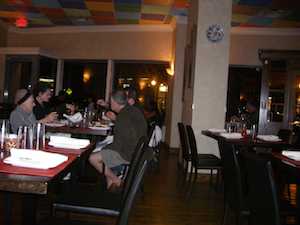 Bosphorus a Turkish and Mediterranean restaurant has taken its place on Hartsdale’s restaurant row, alongside Vega, Harry’s, Azuma, Frankie and Fannuci’s, Masala Kraft and Amendola’s, Bosphorus opened in the wake of Hurricane Irene in the space once occupied by the Hartsdale Cheesery. The site has been thoroughly renovated and features colorful ceiling tiles, hand stenciled columns and an inviting bar. Unlike many newcomers, Bosphorus already has its liquor license so diners don’t need to bring their own bottles.
Bosphorus a Turkish and Mediterranean restaurant has taken its place on Hartsdale’s restaurant row, alongside Vega, Harry’s, Azuma, Frankie and Fannuci’s, Masala Kraft and Amendola’s, Bosphorus opened in the wake of Hurricane Irene in the space once occupied by the Hartsdale Cheesery. The site has been thoroughly renovated and features colorful ceiling tiles, hand stenciled columns and an inviting bar. Unlike many newcomers, Bosphorus already has its liquor license so diners don’t need to bring their own bottles.
The menu is extensive and familiar to those who eat Greek, Israeli or Middle Eastern food. From the long list of hot and cold appetizers we sampled the tabouleh salad which included more greens than wheat as well as “spinach tarator,” -- a creamy mix of sautéed spinach with garlic, yogurt and walnuts. From the hot list we tried the crispy phyllo rolls, a delectable mix of feta, and parsley packaged like cigars in phyllo. There’s hummus, cacik (yogurt, cucumber, mint and dill) babaganush, stuffed grape leaves, and eggplant several ways – or a mixed cold appetizer plate where you can try them all. Hot appetizer selections included spinach pie, fried calamari, pastrami borek and mucver (zucchini pancakes) to name a few.
For dinner choices ranged from lamb and beef, to six chicken dinner as well as grilled fish, shrimp and seafood casserole. Lamb or chicken kebabs were served with rice and were well-spiced and flavorful. For vegetarians there’s a falafel plate, with hummus, tahini sauce and rice and a vegetable casserole.
With only two at the table it was hard to get a full fix on the menu at Bosphorus. But the friendly, attentive, speedy service, the tasty items we ordered and the spacious setting, combined to make a very pleasant evening. We’ll try it again soon and recommend that you stop by too. Sunday night features music, on Thursdays there will be belly dancers and on Wednesday, get one free glass of wine when you order two more.
Bosphorus
213-215 East Hartsdale Avenue
Hartsdale, NY 10530
914-722-2000
Open seven days a week from 12 pm to 11 pm
Take out is available
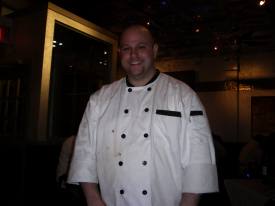 FREE Dinner Offer: In other food news, the 808 Bistro on Scarsdale Avenue will hold a special evening of food and wine featuring the wines of Puglia on Wednesday night September 14th at 7 pm. The price for the dinner is $75 per person including tax and gratuity. To reserve call 722-0808. Chef Salvatore Cucullo has graciously offered to giveaway two complimentary dinners to the first person who responds. If you would like to enter to win, be the first person to respond to [email protected] and put 808 Bistro in the subject line.
FREE Dinner Offer: In other food news, the 808 Bistro on Scarsdale Avenue will hold a special evening of food and wine featuring the wines of Puglia on Wednesday night September 14th at 7 pm. The price for the dinner is $75 per person including tax and gratuity. To reserve call 722-0808. Chef Salvatore Cucullo has graciously offered to giveaway two complimentary dinners to the first person who responds. If you would like to enter to win, be the first person to respond to [email protected] and put 808 Bistro in the subject line.
The Fat Radish: A Cool Spot for a Summer Night
- Details
- Hits: 4211
 We’re always looking for new places to take our city kids to dinner; it’s the sure way to get them to spend some time with the “old folks”. A recent recommendation for The Fat Radish turned out to be a “worth the detour” spot. It may be out of the way for some of us Scarsdalians but I suspect the Lower East Side is familiar territory to many of your offspring. And the good news is that there’s plenty of local parking. Of course you can enjoy the restaurant on your own, but be warned, it’s easier to hide behind your cool 20-somethings so you don’t stick out like sore thumbs!
We’re always looking for new places to take our city kids to dinner; it’s the sure way to get them to spend some time with the “old folks”. A recent recommendation for The Fat Radish turned out to be a “worth the detour” spot. It may be out of the way for some of us Scarsdalians but I suspect the Lower East Side is familiar territory to many of your offspring. And the good news is that there’s plenty of local parking. Of course you can enjoy the restaurant on your own, but be warned, it’s easier to hide behind your cool 20-somethings so you don’t stick out like sore thumbs!
From the minute you walk in, the restaurant is appealing. You’re welcomed by a smiling hostess and if your whole party has not arrived you’re ushered to a tasteful long wood bar to wait. The restaurant has beautiful country wood tables, more open spaces than you expect to see in NYC and high ceilings with a vaulted skylight . Once the drink list is presented you can choose among a variety of wonderful wines from around the world or pick one of the creative cocktails. I had my first taste of aperol which was mixed with Prosecco and lime in the cocktail of the day. It was light and refreshing, perfect for a hot summer night. And things just got better from there.
Fat Radish is a restaurant that specializes in locally sourced food, something a lot of places are doing, but not always 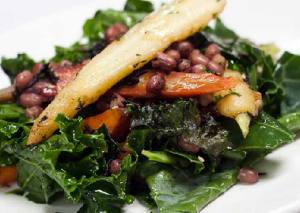 well. Shortly after we sat down our waiter brought a plate of namesake radishes that were tossed in olive oil and sea salt, slightly bitter, but a good nibble. Menu starters include some appealing salads with lots of local vegetables; in fact sources for most of the items were listed on the back (farms, creameries, vineyards, etc). There was a sweet pea pie that looked delicious and someone recommended a selection called grilled cheese and pickles but we kept to the lighter items including a wonderful beet salad and another selection that was loaded with greens and tomatoes. Other choices for our next visit included a kale Caesar salad, handmade pasta and Vermont quail. This is definitely a spot where you could dine well with a couple of small plates.
well. Shortly after we sat down our waiter brought a plate of namesake radishes that were tossed in olive oil and sea salt, slightly bitter, but a good nibble. Menu starters include some appealing salads with lots of local vegetables; in fact sources for most of the items were listed on the back (farms, creameries, vineyards, etc). There was a sweet pea pie that looked delicious and someone recommended a selection called grilled cheese and pickles but we kept to the lighter items including a wonderful beet salad and another selection that was loaded with greens and tomatoes. Other choices for our next visit included a kale Caesar salad, handmade pasta and Vermont quail. This is definitely a spot where you could dine well with a couple of small plates.
While the appetizers seemed more extensive and interesting than the mains, there were enough fish and meat options to appeal to us all. I had the striped bass that was fresh, if not exciting. The vegetarian special with wheat berries got good reviews and the lamb was rare and tasty. We ordered a reasonably priced wine (about $40) and enjoyed the food and ambience. The restaurant was crowded so service was a little slow but our waitress was conscientious. We skipped dessert but there was a very tempting berry something and a variety of cookies that called out to us for next time!
 The check for three with tax and tip (including drinks and wine) was about $200. Appetizers range from $8-$16 and entrees from $16-$28.
The check for three with tax and tip (including drinks and wine) was about $200. Appetizers range from $8-$16 and entrees from $16-$28.
The Fat Radish
17 Orchard Street
New York, N.Y 10002
212-300-4053
Front Café: Monday – Sunday 8 am – 4 pm
Restaurant: Monday – Friday 5:30 pm – 12 am
Saturday 11 am – 4 pm, 5:30 pm – 12 am
Sunday: 11 am – 4pm, 5:30 pm – 10 pm
Chocolate Truffles and the Sidewalk Sale
- Details
- Hits: 4724
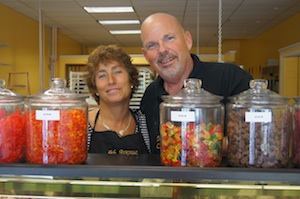 5th Avenue Chocolatiere has opened at 450 Central Park Avenue in the shopping center with Gymboree, Snipits and Central Park Dance. The store offers handmade chocolate truffles, a large array of chocolate candy and specialty ice cream. 5th Avenue Chocolatiere is run by longtime Scarsdale residents Dave and Shelley Larsen who are excited about the launch of their new “chocolate factory.” In addition to chocolate pretzels and chocolate covered fruit, the store creates custom chocolates for special occasions and corporations. The party room in the back will be the setting for chocolate birthday parties where kids can create their own confections. Stop by, check them out and ask to taste their signature chocolate truffle.
5th Avenue Chocolatiere has opened at 450 Central Park Avenue in the shopping center with Gymboree, Snipits and Central Park Dance. The store offers handmade chocolate truffles, a large array of chocolate candy and specialty ice cream. 5th Avenue Chocolatiere is run by longtime Scarsdale residents Dave and Shelley Larsen who are excited about the launch of their new “chocolate factory.” In addition to chocolate pretzels and chocolate covered fruit, the store creates custom chocolates for special occasions and corporations. The party room in the back will be the setting for chocolate birthday parties where kids can create their own confections. Stop by, check them out and ask to taste their signature chocolate truffle.
5th Avenue Chocolatiere
450 Central Park Avenue
Scarsdale, NY 10583
914-713-8879
 The Sidewalk Sale is coming to downtown Scarsdale on Thursday July 28, Friday July 29 and Saturday July 30. On Saturday, there will be entertainment for the whole family in Chase Park, so mark your calendars now. The Scarsdale Chamber of Commerce, who organizes the event, has released the following list of participating stores, restaurants and businesses. Take a look at the impressive line-up and remember to stop by these locations when you shop next week.
The Sidewalk Sale is coming to downtown Scarsdale on Thursday July 28, Friday July 29 and Saturday July 30. On Saturday, there will be entertainment for the whole family in Chase Park, so mark your calendars now. The Scarsdale Chamber of Commerce, who organizes the event, has released the following list of participating stores, restaurants and businesses. Take a look at the impressive line-up and remember to stop by these locations when you shop next week.
- Better Homes and Gardens Rand Real Estate
- Cat Assistance, Inc.
- Classy Consignments
- Courage B
- Country Bank
- David Lerner Associates
- Eastgate Acupuncutre
- En Vogue Ltd.
- E. Nopi
- Etc. Boutique
- Eye Gallery of Scarsdale
- Gingerbread Kidz
- Good-Life Gourmet
- Great Stuff
- Green Design Expo
- Julius Michael Scarsdale
- La Dentelliere
- Lange's Deli
- LF Stores
- LoriCole Designs
- Momotaro Beauty Salon
- NY Sports and Spinal Physical Therapy
- Pamela Robbins
- Parkway Cafe
- Petticoat Lane
- Rothman's Men's Clothing
- Scarsdale Candy and Cards
- Scarsdale Child's Play LTD
- Scarsdale Spencer Pharmacy
- SERVPRO of Scarsdale / Mount Vernon
- Sotheby's International Realty
- Space NK
- Studio II Inc
- The Jewelry Bar
- The Scarsdale Flower Shop
- Upper Cervical Chiropractic of NY
- Zachy's
All Good Things Serves It Up at the Golden Horseshoe
- Details
- Hits: 6790
 It was hot enough to fry an egg on the sidewalk and steamy enough to eat ice cream for breakfast – and that’s what some of the customers seemed to be doing when we visited the new All Good Things ice cream and candy shop in the Golden Horseshoe Shopping Center on Tuesday. Who knew there was so much early morning traffic at an ice cream store – and that most of the customers were full-grown adults, not kids yelling for ice cream!
It was hot enough to fry an egg on the sidewalk and steamy enough to eat ice cream for breakfast – and that’s what some of the customers seemed to be doing when we visited the new All Good Things ice cream and candy shop in the Golden Horseshoe Shopping Center on Tuesday. Who knew there was so much early morning traffic at an ice cream store – and that most of the customers were full-grown adults, not kids yelling for ice cream!
Owner Brian Levy explained that he has been in the area and working with ice cream for as long as he can remember. He grew up in nearby New Rochelle and during high school and college he worked at The Scoop Shop on Palmer Avenue. When Last Licks opened nine years ago he worked for the chain, managing the Scarsdale store and helping to launch six additional locations around Westchester. Most recently, the Last Licks shop in Scarsdale became available, and Levy realized that he would finally have the chance to own his own store. So, in May 2011, Last Licks became All Good Things with Levy at the helm. As a first step, he redesigned the shop, replacing sports memorabilia with music memorabilia and bringing in Emack and Bolio’s Premium Ice Cream from Boston. All Good Things is the only outlet in Westchester selling Emack and Bolios, a brand that may be recognized by those who have lived in Boston.
Despite the early hour, I also decided to have ice cream for breakfast and tasted “Deep Purple Cow,” which is black raspberry ice cream with white and dark chocolate chips. I also sampled a rich, dark chocolate ice cream and was tempted to ask for mud pie which is coffee ice cream with oreos and chocolate shavings and cookie monster; vanilla ice cream with oreos and cookie dough. Levy’s ice cream could quickly become a habit.
white and dark chocolate chips. I also sampled a rich, dark chocolate ice cream and was tempted to ask for mud pie which is coffee ice cream with oreos and chocolate shavings and cookie monster; vanilla ice cream with oreos and cookie dough. Levy’s ice cream could quickly become a habit.
For parties, All Good Things can make custom ice cream cakes priced from $20 to $45 and for a novel twist try their ice cream pizza, which is a brownie crust topped with ice cream and icing.
And if ice cream and frozen yogurt are not enough, the store walls are lined with 100 kinds of candy, 50 flavors of jelly belly jellybeans and large dispensers of M&M’s. Candy is available by the pound and can be packaged in attractive gift boxes to bring to friends or to kids at camp. For camp visiting days, All Good Things also offers cookie cakes.
However, you are welcome to do more than eat at All Good Things. Levy is hoping to create a comfortable environment where customers can meet friends, hang out, and stay as long as they like. After all, he met his wife at the ice cream shop and hopes that all the friends he has made over the years will treat the shop like home.
A new sign is expected to arrive for the store in August – but for now look for the colorful chairs outside All Good Things in the Golden Horseshoe and brighten your day with a cool, sweet treat.
All Good Things
Golden Horseshoe Shopping Center
Wilmot Road
Scarsdale
914-472-1793
Open Sunday – Thursday from 11 am to 10 pm and Friday and Saturday from 11 am to 11 pm
http://www.facebook.com/pages/All-Good-Things/216614421705226
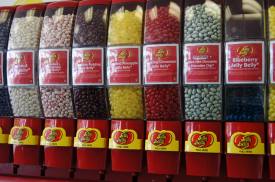
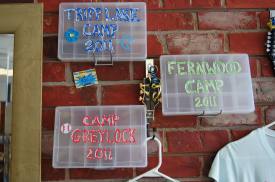
A Tale of Two Restaurants and One Executive Chef: Traditional Meets Innovation
- Details
- Hits: 4837
 It was the best of times and, well actually, continues to be the best of times. When the Executive Chef’s philosophy is “to create food that is simple, straight forward, not over the top, with a harmony of ingredients” and where “eatibility and seasonality” reign, then you know you are in for something great. Chris Vergara, the Executive Chef at not one, but two distinctly wonderful culinary destinations in Westchester is delighted to have accomplished his personal goal of having more than one restaurant before he turned 35. At a very playful 32, creative and talented Chris is proud of Meritage Restaurant opened almost seven years ago in Scarsdale and six month old, Harper’s Bar and Restaurant in Dobbs Ferry.
It was the best of times and, well actually, continues to be the best of times. When the Executive Chef’s philosophy is “to create food that is simple, straight forward, not over the top, with a harmony of ingredients” and where “eatibility and seasonality” reign, then you know you are in for something great. Chris Vergara, the Executive Chef at not one, but two distinctly wonderful culinary destinations in Westchester is delighted to have accomplished his personal goal of having more than one restaurant before he turned 35. At a very playful 32, creative and talented Chris is proud of Meritage Restaurant opened almost seven years ago in Scarsdale and six month old, Harper’s Bar and Restaurant in Dobbs Ferry.
Chris and much of his staff split their time crossing Ardsley Road. Both restaurants benefit from the cross fertilization of experienced service and original cooking expertise. With frequent 1a.m. visits to Hunts Point Market which Chris describes as “another planet, shopping in the equivalent of two football fields of refrigeration” for seafood for both restaurants, he is able to buy the freshest fish sourced from up and down the eastern seaboard. Chris speaks of his “lapse of sanity” in opening two restaurants but does gain some economies of scale and effort in buying ingredients for both at the same time not only from Hunts Point but also from other vendors who supply

In a world where first comes air and water, and food comes next, Culinary Institute of America trained Chris wants his clients to eat with reckless abandon. He grew up in a family in which his mother and grandmother were excellent cooks. By 13, Chris was making elaborate meals for his pals. Accordingly, he wanted to “create home cooked food that was real, made with love and not pumped out en masse.”
Meritage Restaurant ( meritagerestaurant.net ), like its’ name which comes from a California wine blend, is old world meets new world maintaining the best of the traditional but adding a savory flourish. A longstanding Scarsdale favorite with a caste of regulars, the menu offers fine new American cuisine in a serene setting.

Two outstanding restaurants, one great Executive Chef and all north of the city. Reservations are recommended but walk-ins are welcome.
Meritage Restaurant
1505 Weaver Street
Scarsdale
914 472 8484
http://www.meritagerestaurant.net/
Harper’s Bar and Grill
92 Main Street
Dobbs Ferry
914 693 2506
http://www.harpersonmain.com/










